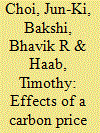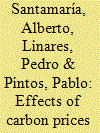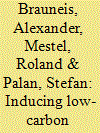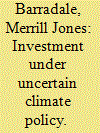|
|
|
Sort Order |
|
|
|
Items / Page
|
|
|
|
|
|
|
| Srl | Item |
| 1 |
ID:
117339


|
|
|
|
|
| Publication |
2013.
|
| Summary/Abstract |
This paper employs a novel Monte-Carlo based generation portfolio assessment tool to explore the implications of increasing wind penetration and carbon prices within future electricity generation portfolios under considerable uncertainty. This tool combines optimal generation mix techniques with Monte Carlo simulation and portfolio analysis methods to determine expected overall generation costs, associated cost uncertainty and expected CO2 emissions for different possible generation portfolios. A case study of an electricity industry with coal, Combined Cycle Gas Turbines (CCGT), Open Cycle Gas Turbines (OCGT) and wind generation options that faces uncertain future fossil-fuel prices, carbon pricing, electricity demand and plant construction costs is presented to illustrate some of the key issues associated with growing wind penetrations. The case study uses half-hourly demand and wind generation data from South Eastern Australia, and regional estimates of new-build plant costs and characteristics. Results suggest that although wind generation generally increases overall industry costs, it reduces associated cost uncertainties and CO2 emissions. However, there are some cases in which wind generation can reduce the overall costs of generation portfolios. The extent to which wind penetration affects industry expected costs and uncertainties depends on the level of carbon price and the conventional technology mix in the portfolios.
|
|
|
|
|
|
|
|
|
|
|
|
|
|
|
|
| 2 |
ID:
096719


|
|
|
|
|
| Publication |
2010.
|
| Summary/Abstract |
Despite differences in their implementation, most carbon policies aim to have similar outcomes: effectively raising the price of carbon-intensive products relative to non-carbon-intensive products. While it is possible to predict the simple broad-scale economic impacts of raising the price of carbon-intensive products-the demand for non-carbon-intensive products will increase-understanding the economic and environmental impacts of carbon policies throughout the life cycle of both types of products is more difficult. Using the example of a carbon tax, this study proposes a methodology that integrates short-term policy-induced consumer demand changes into the input-output framework to analyze the environmental and economic repercussions of a policy. Environmental repercussions include the direct and the indirect impacts on emissions, materials flow in the economy, and the reliance on various ecosystem goods and services. The approach combines economic data with data about physical flow of fossil fuels between sectors, consumption of natural resources and emissions from each sector. It applies several input-output modeling equations sequentially and uses various levels of aggregation/disaggregation. It is illustrated with the data for the 2002 U.S. economy and physical flows. The framework provides insight into the short-term complex interactions between carbon price and its economic and environmental effects.
|
|
|
|
|
|
|
|
|
|
|
|
|
|
|
|
| 3 |
ID:
097512


|
|
|
|
|
| Publication |
2010.
|
| Summary/Abstract |
Despite differences in their implementation, most carbon policies aim to have similar outcomes: effectively raising the price of carbon-intensive products relative to non-carbon-intensive products. While it is possible to predict the simple broad-scale economic impacts of raising the price of carbon-intensive products-the demand for non-carbon-intensive products will increase-understanding the economic and environmental impacts of carbon policies throughout the life cycle of both types of products is more difficult. Using the example of a carbon tax, this study proposes a methodology that integrates short-term policy-induced consumer demand changes into the input-output framework to analyze the environmental and economic repercussions of a policy. Environmental repercussions include the direct and the indirect impacts on emissions, materials flow in the economy, and the reliance on various ecosystem goods and services. The approach combines economic data with data about physical flow of fossil fuels between sectors, consumption of natural resources and emissions from each sector. It applies several input-output modeling equations sequentially and uses various levels of aggregation/disaggregation. It is illustrated with the data for the 2002 U.S. economy and physical flows. The framework provides insight into the short-term complex interactions between carbon price and its economic and environmental effects.
|
|
|
|
|
|
|
|
|
|
|
|
|
|
|
|
| 4 |
ID:
125838


|
|
|
|
|
| Publication |
2013.
|
| Summary/Abstract |
To address the climate change issue, developed nations have considered introducing carbon pricing mechanisms in the form of a carbon tax or an emissions trading scheme (ETS). Despite the small number of programmes actually in operation, these mechanisms remain under active discussion in a number of countries, including Japan. Using an input-output model of the Japanese economy, this article analyses the effects of carbon pricing on Japan's industrial sector. We also examine the impact of a rebate programme of the type proposed for energy-intensive trade-exposed (EITE) industries in U.S. legislation, the Waxman-Markey Bill (H.R. 2454), and in the European Union's ETS. We find that a carbon pricing scheme would impose a disproportionate burden on a limited number of sectors - namely, pig iron, crude steel (converters), cement and other EITE industries. Out of 401 industries, 23 would be eligible for rebates according to the Waxman-Markey-type programme, whereas 122 industries would be eligible for rebates according to the E.U.-type programme, if adopted in Japan. Overall, despite the differences in coverage, we find that the Waxman-Markey and E.U. rebate programmes have roughly similar impacts in reducing the average burden on EITE industries.
|
|
|
|
|
|
|
|
|
|
|
|
|
|
|
|
| 5 |
ID:
127301


|
|
|
|
|
| Publication |
2014.
|
| Summary/Abstract |
This paper assesses the impacts on the cement, steel and oil refining sectors in Spain of the carbon prices derived from the European Emissions Trading Scheme (EU ETS), and the potential effect on these sectors of the European Union anti-leakage policy measures. The assessment is carried out by means of three engineering models developed for this purpose. Our results show a high exposure to leakage of cement in coastal regions; a smaller risk in the steel sector, and non-negligible risk of leakage for the oil refining sector when carbon allowance prices reach high levels. We also find that the risk of leakage could be better handled with other anti-leakage policies than those currently in place in the EU.
|
|
|
|
|
|
|
|
|
|
|
|
|
|
|
|
| 6 |
ID:
171409


|
|
|
|
|
| Summary/Abstract |
The implementation of a national emissions trading scheme (ETS) in China is likely to have an important effect on potential regional gains. This study proposes a unified analytical framework for anticipating such gains in 2020 and estimates the key factors involved using data envelopment analysis based models. The results indicate that: (1) when the value of the marginal abatement cost is higher than the carbon price, no regions will have an incentive to reduce emissions by technological improvements. The only source of direct potential gains is from the amounts of carbon quota. (2) As carbon price increases from CNY 10 to 4000 per ton, the indirect potential gains will increase because the strategies for carbon reduction are technological innovation or limit economic activities. However, Jiangsu and Shanghai will suffer potential losses even though the price is high because they have no more carbon reduction potential. (3) Most central provinces will have potential gains when the carbon price is lower in ETS, while regions rich in fossil energy sources will suffer potential losses. However, a middle-price interval of CNY 1000–2000/ton is more rational, because it helps motivate market transactions and benefits low-carbon technological innovations.
|
|
|
|
|
|
|
|
|
|
|
|
|
|
|
|
| 7 |
ID:
124504


|
|
|
|
|
| Publication |
2013.
|
| Summary/Abstract |
The European electricity market is linked to a carbon market with a fixed cap that limits greenhouse gas emissions. At the same time, a number of energy efficiency policy instruments in the EU aim at reducing the electricity consumption. This article explores the interactions between the EU's carbon market on the one hand and instruments specifically targeted towards energy end-use efficiency on the other hand. Our theoretical analysis shows how electricity demand reduction triggered by energy efficiency policy instruments affects the emission trading scheme. Without adjustments of the fixed cap, decreasing electricity demand (relative to business-as-usual) reduces the carbon price without reducing total emissions. With lower carbon prices, costly low emission processes will be substituted by cheaper high emitting processes. Possible electricity and carbon price effects of electricity demand reduction scenarios under various carbon caps are quantified with a long-term electricity market simulation model. The results show that electricity efficiency policies allow for a significant reduction of the carbon cap. Compared to the 2005 emission level, 30% emission reductions can be achieved by 2020 within the emission trading scheme with similar or even lower costs for the industrial sector than were expected when the cap was initially set for a 21% emission reduction.
|
|
|
|
|
|
|
|
|
|
|
|
|
|
|
|
| 8 |
ID:
103491


|
|
|
|
|
| Publication |
2011.
|
| Summary/Abstract |
This paper compares the incentives a carbon dioxide emissions price creates for investment in low carbon dioxide-emitting technologies in the electricity sector. We consider the extent to which operational differences across generation technologies - particularly, nuclear, wind and solar photovoltaic - create differences in the incentives for new investment, which is measured by the operating profits of a potential entrant. First, astylized model of an electricity system demonstrates that the composition of the existing generation system may cause electricity prices to increase by different amounts over time when a carbon dioxide price is imposed. Differences in operation across technologies therefore translate to differences in the operating profits of a potential entrant. Then, a detailed simulation model is used to consider a hypothetical carbon dioxide price of $10-$50 per metric ton for the Electric Reliability Council of Texas (ERCOT) market. The simulations show that, for the range of prices considered, the increase in electricity prices is positively correlated with output from a typical wind unit, but the correlation is much weaker for nuclear and photovoltaic. Consequently, a carbon dioxide price creates much stronger investment incentives for wind than for nuclear or photovoltaic technologies in the Texas market.
|
|
|
|
|
|
|
|
|
|
|
|
|
|
|
|
| 9 |
ID:
117318


|
|
|
|
|
| Publication |
2013.
|
| Summary/Abstract |
Uncertainty about long-term climate policy is a major driving force in the evolution of the carbon market price. Since this price enters the investment decision process of regulated firms, this uncertainty increases the cost of capital for investors and might deter investments into new technologies at the company level. We apply a real options-based approach to assess the impact of climate change policy in the form of a constant or growing price floor on investment decisions of a single firm in a competitive environment. This firm has the opportunity to switch from a high-carbon "dirty" technology to a low-carbon "clean" technology. Using Monte Carlo simulation and dynamic programming techniques for real data, we determine the optimal CO2 price floor level and growth rate in order to induce investments into the low-carbon technology. We find that a carbon price floor can be used to induce earlier low-carbon technology investment and show this result to be robust to a large variety of input parameter settings.
|
|
|
|
|
|
|
|
|
|
|
|
|
|
|
|
| 10 |
ID:
132686


|
|
|
|
|
| Publication |
2014.
|
| Summary/Abstract |
This paper introduces the concept of payment probability as an important component of carbon risk (the financial risk associated with CO2 emissions under uncertain climate policy). In modeling power plant investment decisions, most existing literature uses the expected carbon price (e.g., the price of traded permits or carbon tax) as a proxy for carbon risk. In contrast, this paper identifies expected carbon payment as a more accurate measure of carbon risk as perceived by industry practitioners. This measure of carbon risk incorporates both expected price and the probability that this price would actually be faced in the case of a particular investment. This concept helps explain both the surge of activity in 2005-2006 and the subsequent decline in interest in coal-fired power plant development in the U.S. The data for this case study comes from an extensive online survey of 700 U.S. energy professionals completed in 2006, as well as interviews conducted with industry representatives from 2007 to 2009. By analyzing industry views on policy uncertainty and future carbon legislation, we gain a better understanding of investor attitudes toward carbon risk. This understanding will help policy makers design better incentives for investing in low-carbon technologies.
|
|
|
|
|
|
|
|
|
|
|
|
|
|
|
|
| 11 |
ID:
166722


|
|
|
|
|
| Summary/Abstract |
The current Korean administration is driving change in the power sector by gradually phasing out nuclear power plants, expanding the use of renewable energy, and imposing restrictions on the operation of coal power plants. Considering these changes, the marginal abatement cost (MAC) curve would provide crucial information to determine an appropriate greenhouse gas reduction target, especially for 2030. This study derives the MAC curves for the Korean power sector in 2030 using a bottom-up optimization model with three scenarios based on different carbon pricing schedules. In addition, the carbon price required to achieve the CO2 emission targets in the Korean power sector in 2030 are estimated. The results show that a carbon price of 135–157 US$/tCO2 would be required to achieve the 2030 emission target for the power sector. By comparing the MAC curves of three different scenarios, we can reiterate the fact that early action regarding climate change mitigation is more effective and efficient than delayed action.
|
|
|
|
|
|
|
|
|
|
|
|
|
|
|
|
| 12 |
ID:
150680


|
|
|
|
|
| Summary/Abstract |
The European Commission discusses the change of free allocation plans to guarantee a stable market equilibrium. Selling over-allocated contracts effectively depreciates prices and negates the effect intended by the regulator to establish a stable price mechanism for CO2 assets. Our paper investigates mispricing and allocation issues by quantitatively analyzing variance risk premia of CO2 markets over the course of changing regimes (Phase I-III) for three different assets (European Union Allowances, Certified Emissions Reductions and European Reduction Units). The research paper gives recommendations to regulatory bodies in order to most effectively cap the overall carbon dioxide emissions.
|
|
|
|
|
|
|
|
|
|
|
|
|
|
|
|
|
|
|
|
|